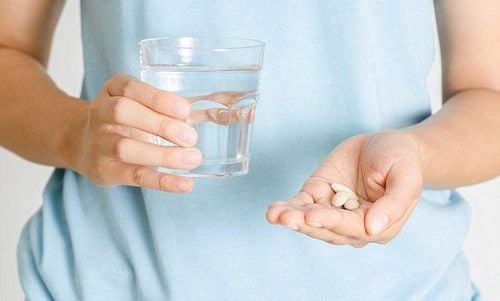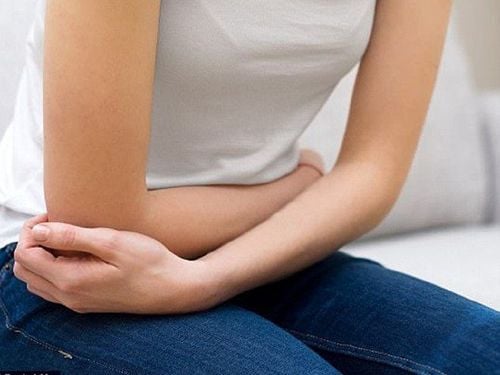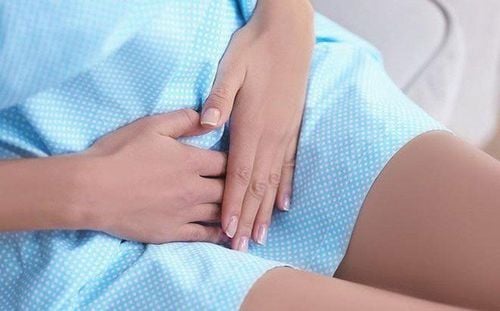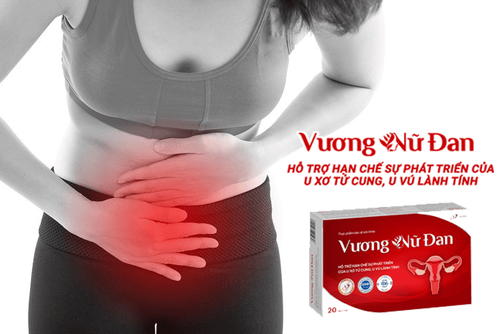This is an automatically translated article.
Dysmenorrhea is a normal physiological condition and can be experienced in different degrees depending on the subject. However, in addition to the physiological manifestations, menstrual pain that is severe and increases over time may be caused by an abnormal cause in the pelvic area.
1. What is dysmenorrhea?
Dysmenorrhea is a sharp or spasmodic pain in the lower abdomen, usually occurring days before and during menstruation. Many women find this pain just a little uncomfortable, tiring and has little impact on life. In contrast, some experience severe menstrual cramps that can interfere with their normal activities for a few days.
Based on the cause of dysmenorrhea, it is classified into 2 types as follows:
Primary dysmenorrhea: The pain occurs repeatedly during menstruation and is not related to other medical conditions. The pain usually begins about 1–2 days before or during the menstrual cycle. Manifestations are pain in the lower abdomen, sometimes accompanied by back or thigh pain, fatigue, diarrhea, nausea and vomiting. The severity of abdominal pain varies from person to person and usually lasts from 1 to 3 days. Secondary dysmenorrhea: Usually related to a disorder or disease of the female reproductive organs. This type of secondary pain usually occurs before a period and lasts longer than regular dysmenorrhea. Secondary dysmenorrhea is usually not accompanied by symptoms such as nausea, vomiting, fatigue, or diarrhea.

Đau bụng kinh dữ dội khiến phụ nữ cảm thấy mệt mỏi
2. Causes of severe abdominal pain
2.1. Causes of primary dysmenorrhea Normally during a menstrual cycle, under the influence of hormones, the uterine lining will thicken to facilitate implantation of the fertilized embryo. But if there is no fertilization, under the influence of hormones, the uterine muscle contracts, causing the blood vessels that nourish the lining to be compressed, not to fall off and the uterus will have to contract to push the lining out. blood during menstruation.
Due to the temporary interruption of blood and oxygen supply, tissues release chemical mediators called prostaglandins. This substance causes the muscles in the uterus to contract more and more strongly, thereby increasing the level of pain during this time.
Some women have more severe abdominal pain every month than others which can be explained by a buildup of prostaglandins. Since then, the process of uterine contractions occurs strongly, causing severe menstrual pain.
In addition, a number of factors can contribute to increased dysmenorrhea including:
The earlier the age of menarche, the greater the risk of severe pain; The structure of the cervical opening is very narrow, making it difficult for menstrual blood to escape, so the uterus will have to contract more strongly; Family history of severe dysmenorrhea; Prolonged menstruation ; Less exercise. 2.2. Causes of dysmenorrhea secondary causes Usually, if severe menstrual pain is caused by primary, it will gradually decrease over time, with age, the pain level will gradually decrease. The pain usually goes away after giving birth. However, if there is no decrease or increase it can be caused by a number of pelvic abnormalities including:
Uterine fibroids : This is a tumor that grows in the muscle of the uterus. They vary in size from person to person, from very small to very large. Women with fibroids may see a single or multiple fibroids. When having uterine fibroids, the patient will often have more pain when the menstrual cycle comes, there is a risk of menorrhagia ...; Endometriosis: This is a cause of severe pain during periods in women. Endometriosis is a condition in which endometrial cells not only grow in the uterus but are also found outside a woman's uterus such as the ovaries, fallopian tubes, inside the uterine muscle, and on the bladder. optical. The characteristics of these ectopic endometrium are similar to that of normal endometrium, they also grow under the influence of hormones and also cause bleeding. It is this that causes pain, especially during menstruation. In particular, the case of endometriosis in the myometrium; Ovarian cysts: These are fluid-filled sacs that can form in the ovaries like follicles. But when the ovum inside the follicles is not released or the sac formed by the egg does not dissolve after the egg is released, a cyst can form. It is also the cause of pelvic and menstrual pain in women; Pelvic inflammatory disease: People with tubal inflammation, inflammation of the cervix or uterus... also cause them to have more pain each period; Some rare causes include: Congenital uterine malformations, uterine adhesions, pain due to psychological factors...

Massage vùng bụng giúp giảm cơn đau
3. Some ways to cure severe menstrual pain You can apply some of the ways to treat severe menstrual pain as follows:
Warm compress: Use a hot pack or just use a warm water bottle to apply to the abdomen area. relaxes muscles and helps relieve pain. In addition, you can use some herbs such as wormwood, white salt and then roasted to warm, then apply to the painful abdomen is also quite effective. Exercise regularly: Regular exercise also makes your body less painful every time your period comes. In the days leading up to your period, you can do gentle exercises such as yoga, walk or do muscle stretches that will help release the hormone endorphin, which is considered a natural pain reliever. Proper rest: When your period is coming, you should rest enough, avoid overwork that makes the body tired and the pain does not subside. In particular, stress should be avoided because this is a contributing factor to increased menstrual pain. Abdominal self-massage: Abdominal massage to help relax muscles is also an effective measure to reduce abdominal pain. To increase the effect, it can be combined with rose, cinnamon or clove essential oils. Use hot and warm foods: Avoid foods that are cold because it makes your stomach hurt more. Some warm foods such as ginger, wormwood... should be used during menstruation. Acupressure for menstrual pain: Before or during your period, you can press some acupressure points to help relieve abdominal pain. Some acupoints that can relieve dysmenorrhea include: Blood Sea (determined by measuring 1 cun up from the midpoint of the upper border of the kneecap and 2 cun inward); Thai Pulse acupoint (located in the slit between the 1st and 2nd foot vertebrae, measuring up to 1.5 cun); Tam Yin Giao acupoint (at the top of the inner ankle measures up to 3 cun); Uterine acupoint (located 4 cun below the navel and 3 cun across both sides). It is recommended to massage each point for about 2 to 3 minutes. Using pain relievers: Pain relievers are generally not recommended, but if the above measures are not effective and the pain is affecting your daily activities, you can consult your doctor. to use. Over-the-counter pain relievers such as Motrin and Tylenol can help reduce inflammation and menstrual cramps effectively. Examination: Severe menstrual pain if it affects your monthly life much and the pain symptoms become more severe or you have just had severe menstrual pain when you are over 25 years old, you should go to a medical facility. visit to find out the cause and appropriate treatment. As such, there are many possible causes of severe menstrual cramps. If you feel that your period pain is heavy or seriously affects your life, visit your doctor to rule out secondary causes and get the right care and treatment.
Please dial HOTLINE for more information or register for an appointment HERE. Download MyVinmec app to make appointments faster and to manage your bookings easily.













